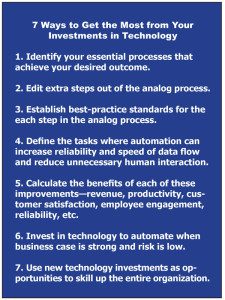
 Hoping that technology will lead employees to do what they aren’t currently doing, managers and executives leap right into automation without giving due process to the foundational steps of “simplify” and “standardize.” Mistakenly, they think technology will jump-start behavioral change or define a more robust strategy.
Hoping that technology will lead employees to do what they aren’t currently doing, managers and executives leap right into automation without giving due process to the foundational steps of “simplify” and “standardize.” Mistakenly, they think technology will jump-start behavioral change or define a more robust strategy.
Often, however, lobbing technology solutions into a complex system ends up creating more activities rather than fewer, and this builds operational clutter inside the organization. Skipping steps actually results in decreased efficiency and productivity.
Consider your new-product development process. It includes strategy, idea generation, concept testing, business analysis, development, test marketing and commercialization. Each stage functions like a gate; if an idea is unable to clear the hurdles presented at that stage, it can’t advance to the next. When it comes to technology, however, it’s not uncommon for managers to jump right into installing a new platform or software and then mandating its immediate use.
APPROACH TECH INVESTMENTS LIKE NEW-PRODUCT DEVELOPMENT
Using a systematic process that is heavily front-loaded will ensure successful outcomes. The three-phase process of simplify, standardize, and automate (SSA) allows executives to be clear on what problems they are hoping to solve and new opportunities they want the solution to create. Returns on technology investments become easier to model after the first two steps. By establishing milestones of success, the investments of time, energy, and capital are maximized. Before applying technology, perfect your analog process.
0

1:00 - 5:00 pm
Over 70% of Executives Surveyed Agree: Many Strategic Planning Efforts Lack Systematic Approach Tips for Enhancing Your Strategic Planning Process
Executives expressed frustration with their current strategic planning process. Issues include:
Steve Rutan and Denise Harrison have put together an afternoon workshop that will provide the tools you need to address these concerns. They have worked with hundreds of executives to develop a systematic approach that will enable your team to make better decisions during strategic planning. Steve and Denise will walk you through exercises for prioritizing your lists and steps that will reset and reinvigorate your process. This will be a hands-on workshop that will enable you to think about your business as you use the tools that are being presented. If you are ready for a Strategic Planning tune-up, select this workshop in your registration form. The additional fee of $695 will be added to your total.

2:00 - 5:00 pm
Female leaders face the same issues all leaders do, but they often face additional challenges too. In this peer session, we will facilitate a discussion of best practices and how to overcome common barriers to help women leaders be more effective within and outside their organizations.
Limited space available.

10:30 - 5:00 pm
General’s Retreat at Hermitage Golf Course
Sponsored by UBS
General’s Retreat, built in 1986 with architect Gary Roger Baird, has been voted the “Best Golf Course in Nashville” and is a “must play” when visiting the Nashville, Tennessee area. With the beautiful setting along the Cumberland River, golfers of all capabilities will thoroughly enjoy the golf, scenery and hospitality.
The golf outing fee includes transportation to and from the hotel, greens/cart fees, use of practice facilities, and boxed lunch. The bus will leave the hotel at 10:30 am for a noon shotgun start and return to the hotel after the cocktail reception following the completion of the round.